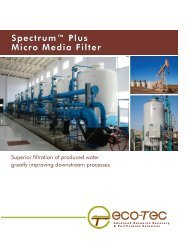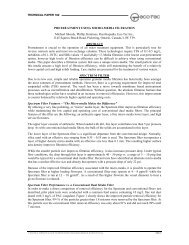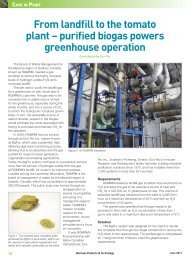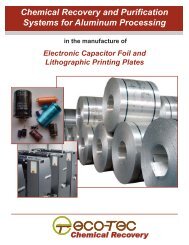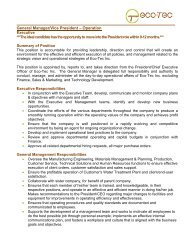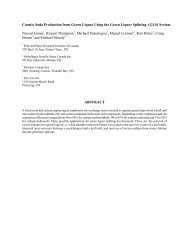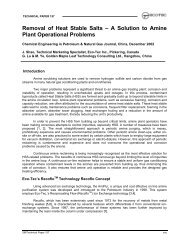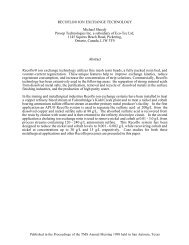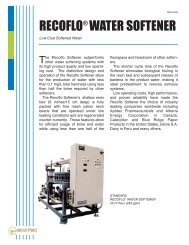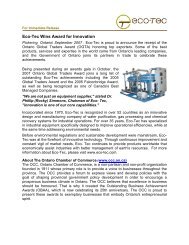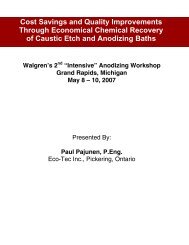EFFECTIVENESS OF CONTINUOUS REMOVAL OF - Eco-Tec
EFFECTIVENESS OF CONTINUOUS REMOVAL OF - Eco-Tec
EFFECTIVENESS OF CONTINUOUS REMOVAL OF - Eco-Tec
Create successful ePaper yourself
Turn your PDF publications into a flip-book with our unique Google optimized e-Paper software.
TECHNICAL PAPER 191<br />
<strong>EFFECTIVENESS</strong> <strong>OF</strong> <strong>CONTINUOUS</strong> <strong>REMOVAL</strong><br />
<strong>OF</strong> HEAT STABLE SALTS FROM<br />
CONTAMINATED AMINE SCRUBBING SOLUTIONS<br />
Jenny Shao, VP Business Development, Asia<br />
<strong>Eco</strong>-<strong>Tec</strong> Inc., Ontario, Canada<br />
jshao@eco-tec.com<br />
Lloyd Vaz, Chief Executive<br />
<strong>Eco</strong>-<strong>Tec</strong> Solutions, Pune, India<br />
eco-tec@eco-tecsolutions.com<br />
www.eco-tec.com<br />
ABSTRACT<br />
Amine scrubbing solutions used for gas treatment at refineries, chemical, sulfur and<br />
gas processing plants remove hydrogen sulfide and carbon dioxide from gas streams. One<br />
of the problems with the amine solutions is the gradual accumulation of byproduct<br />
contaminants called heat stable salts (HSS). Increased HSS concentration in the amine<br />
loop leads to corrosion-related maintenance problems, frequent filter replacements, amine<br />
losses, excessive foaming, capacity reduction, etc.<br />
Ion exchange resins have been employed for removal of the HSS, but because of the<br />
different affinities that the various anionic HSS contaminants have towards the resin,<br />
successful removal is restricted. Moreover, continuous on line removal of the HSS, rather<br />
than periodic treatment helps ensure a more stable and uniform conditioning operation<br />
with optimized efficiency of the amine unit operation.<br />
A proprietary system, employing advanced ion exchange technology with unique<br />
features of fine mesh resins, short packed bed and fast cycles was introduced to this<br />
application about 10 years ago and has proved most successful in achieving the needs of<br />
efficient online HSS removal. Since then, several such systems have been installed<br />
around the world including India. This paper details the technology and various<br />
applications, including carbon dioxide sequestration. Various examples are presented,<br />
with two specific case studies: a system installation in the United States of America, and<br />
an installation in China.
TECHNICAL PAPER 191<br />
INTRODUCTION<br />
The amine-treating unit is of great importance in gas processing and refinery<br />
operations for treating acid gases and now attracts increasing attention due to the pressing<br />
needs of environmental compliance and meeting the stringent levels of H 2 S and CO 2<br />
removal. Lean amine solutions of 20-50 wt.% and relatively free of acid gases enters the<br />
top of the absorption tower and flows counter-current to the sour gas stream being fed<br />
from the bottom of the column. The acid gases in the gas stream are chemically absorbed<br />
resulting in rich amine solution that exits from the bottom of the tower and the sweet gas<br />
from the tower top.<br />
Thermal regeneration of the rich amine is then carried out in a steam stripper where<br />
the absorbed acid gases are liberated and this regenerated (lean) amine is re-circulated<br />
back to the absorption tower top.<br />
In the absorption process, a common problem is the formation of small quantities of<br />
Heat Stable Salts (HSS), which is not removed during steam stripping. HSS is formed<br />
due to the presence of other certain acidic components in the process gas and liquids that<br />
result in an irreversible reaction with the amine to form HSS. These contaminants include<br />
chloride, sulfate, formate, acetate, exalate, cynamide, thiocynate, thiosulfate, etc. The<br />
resultant salts have a relatively strong chemical bonding with essentially no dissociation<br />
with heat (in the steam stripper). This result in the gradual build up of the HSS in the<br />
amine circulation loop and when the tolerable limits of the HSS are exceeded several<br />
operational and maintenance problems are encountered some of which include:<br />
• High corrosion rates leading to stress corrosion cracking;<br />
• High maintenance, repair cost and safety concerns;<br />
• Frequent filter replacements;<br />
• Foaming and plugging in absorber tower;<br />
• Decrease in absorption efficiency and productivity;<br />
• Heat exchanger and reboiler tube fouling;<br />
• Excessive heat requirements;<br />
• Overall unit instability.<br />
High corrosion rates, typical for a number of amine plants, as well as stress-corrosion<br />
cracking of stainless steel, usually attributed to chloride, create serious safety concerns.<br />
High corrosion leads to high repair and maintenance costs, potential environmental<br />
implications, as well as lost production. The results of a survey conducted by the National<br />
Association of Corrosion Engineers (NACE) indicate that 60% of total 24 amine plants<br />
surveyed experience stress-corrosion cracking in the amine absorbers 1 . A similar survey<br />
by the Japanese Petroleum Institute reported a 72% occurrence of cracking at amine gas<br />
treating facilities. Carbon steel corrosion is often attributed to the amine contaminants<br />
which cannot be stripped and thereby accumulate in the amine solution. However,<br />
preventive measures to reduce corrosion produce good results and improve amine unit<br />
reliability at a reasonable cost.
TECHNICAL PAPER 191<br />
<strong>CONTINUOUS</strong> RECLAMATION TO CONTROL IMPURITIES<br />
In order to prevent the HSS from building up beyond critical limits, the most straightforward<br />
approach is periodic amine purging which is messy and prohibitively expensive<br />
given the current situation of increased competition, cost control and restricted waste<br />
discharge. Other periodic amine clean-ups, either on-site or off-site, are also practiced to<br />
some extent by certain plants that have to employ large equipment for vacuum distillation,<br />
conventional ion exchange or electro-dialysis. However, this approach of periodic<br />
reclaiming is cumbersome and expensive and does not effectively overcome the<br />
operational and corrosion problems caused by the anions.<br />
It became apparent that the ideal solution to overcome HSS related problems was to<br />
have on-line amine purification (and not periodic) which would ensure a stable and<br />
uniform gas conditioning operation while the contaminant levels in the amines are<br />
restricted from building up and corrosion rate minimized.<br />
As depicted in diagram 1, continuous on-line amine reclaiming has become recognized<br />
as the most effective solution for HSS-related problems. Furthermore, if an upset occurs<br />
upstream of the amine unit, the equipment is on-site to address the problem immediately.<br />
In 1998, such an on-line<br />
system employing advanced<br />
ion exchange technology<br />
with unique features of fine<br />
mesh resins, short packed<br />
bed and fast cycles was<br />
introduced to this application<br />
and has proved most<br />
successful in achieving the<br />
needs of efficient HSS<br />
removal. Since then, several<br />
such systems have been<br />
installed around the world<br />
including India. Some of the<br />
features, differentiating this<br />
Diagram 1: Continuous Online Loop<br />
unique ion exchange technology from<br />
conventional ion-exchange systems, include:<br />
• fine mesh resins;<br />
• short & packed resin bed;<br />
• countercurrent regeneration;<br />
• low resin loading;<br />
• fast flows and short cycles;<br />
• compact and skid mounted system.<br />
Systems employing this unique ion exchange technology were originally in use two<br />
decades earlier but for various other industrial applications for chemical purification,<br />
recovery and recycling (steel finishing operations, electro-plating, etc.).
TECHNICAL PAPER 191<br />
For the Amine Purification System there are basically two steps in the operating<br />
cycle: amine contaminant loading and caustic regeneration. This cycle is automatically<br />
repeated every 10-15 minutes.<br />
Skid-Mounted AmiPur System<br />
1. Lean amine solution is pumped through the resin bed. The ion exchange resin<br />
removes the heat stable salts (HSS) and the purified amine solution is directed<br />
to the flash tank or returned into the amine loop.<br />
Loading step: R’OH + RN 3 + HHCOO -<br />
R’HCOO + RN 3 + H 2 O<br />
2. Dilute caustic soda is used to regenerate the resin column. The unit draws<br />
concentrated caustic from the bulk tank which is automatically diluted to the<br />
proper concentration before passing through the resin bed. After a few<br />
minutes of regeneration, a water wash rinses out the excess caustic from the<br />
resin bed and a new cycle starts.<br />
Regeneration step: R’HCOO + NaOH<br />
R’OH + HCOONa<br />
Note: R’OH – resin surface, RN 3 – tertiary amine, HCOOH - HSS<br />
An initial on-line Amine Purification (AmiPur) System was installed at the Crown<br />
Central Petroleum Corporation (CCPC) refinery at Texas, U.S in 1998. The analysis of<br />
the system’s “in” and “out” streams demonstrated that in addition to the removal of<br />
acetate, thiocyanate and other anions, it also reduced iron level. This, together with<br />
significant formate removal capacity, resulted in a dramatic decrease in corrosion rates<br />
and filter plugging at the Pasadena refinery.
TECHNICAL PAPER 191<br />
Since then, this system has been successfully tested on all the major types of amines<br />
(Figure 1). Existing installations are operating on MDEA and DEA solutions, both at<br />
main amine and tail gas units, and have resulted in significant operating benefits for the<br />
amine plants.<br />
MDEA<br />
DEA<br />
MEA<br />
Formate<br />
Thiocyanate<br />
Acetate<br />
Thiosulfate<br />
Sulfate<br />
Oxalate<br />
Chloride<br />
Total HSS<br />
1<br />
2<br />
3<br />
4<br />
5<br />
6<br />
7<br />
8<br />
1<br />
2<br />
3<br />
4<br />
5<br />
6<br />
7<br />
8<br />
0 0.5 1 1.5 2 2.5 3<br />
0 0.5 1 1.5 2 2.5 3<br />
0 1 2 3 4 5 6 7<br />
Figure 1: Anion removal by AmiPur , <strong>Eco</strong>-<strong>Tec</strong> laboratory data<br />
CASE STUDY I: CROWN CENTRAL PETROLEUM CORPORATION<br />
This refinery has both primary and tail gas amine treating systems. MDEA is used at<br />
the present time in both amine systems. The primary amine unit contains a gas liquid<br />
contactor or fuel gas absorber, a spare fuel gas absorber, a liquid-liquid C3/C4 amine<br />
treater, one amine regenerator, a flash drum, heat exchangers, amine filter, a slipstream<br />
amine reclaimer, and several associated pumps. For the main fuel gas absorber, the<br />
tower’s pressure drop is measured over the inlet gas line to outlet gas line, and this is<br />
used to monitor tower plugging and foaming.<br />
• The liquid-liquid amine contactor is a trayed tower with 15 trays. It is designed to<br />
remove about 1,000 PPM H 2 S from 21,000 BPD C3/C4 mix.<br />
• The tail gas unit’s amine system is very similar to the main amine system, with no<br />
flash drum and only a single amine absorber.<br />
The MDEA amine solution absorbs the H 2 S from the gas and liquid feeding the<br />
refiner’s absorbers, and these absorbers send the rich amine to be regenerated in a<br />
relatively simple processing scheme. The amine unit contacts the refinery off gas<br />
products from the various unit operations, and while removing H 2 S; the contact in the<br />
absorbers allows the amine to react with other species in the gas and liquid streams,<br />
causing the amine to chemically degrade. These unwanted reactions are known to occur<br />
with oxygen, CO, SO 2 cyanides, organic acids such as formates and acetates, inorganic<br />
acids such as HCl and H 2 SO 4 , all of which can and will be present in the off gas products<br />
from the refinery.<br />
As HSS build, the amine filters plugged more frequently. A decrease in the amine<br />
filter life is usually the first sign of increased corrosion, and starts in the hot lean amine<br />
system that feeds the amine filters. If the amine filters do not adequately remove these<br />
products of corrosion, filter life may not be affected, but the amine solution color will be<br />
dark. Dark amine solution feeding a packed absorber tower will certainly lead to tower
TECHNICAL PAPER 191<br />
plugging and foaming. This foaming then leads to increased amine losses, and the<br />
increased amine make up can temporarily reduce the HSS to slow the corrosion and<br />
improve the amine quality. As the HSS again start to build, the cycle starts again.<br />
Low-level contaminants in the amine contactors degrade the MDEA and form the<br />
HSS, and accumulation of the salts begins to affect amine unit performance. The only<br />
way to break this frustrating cycle is to remove these salts from the solution continuously<br />
and not allow the accumulation.<br />
At Crown Central Petroleum’s Pasadena, Texas refinery, a compressed-bed ion<br />
exchange reclaiming unit was installed in 1998 to effectively remove HSS from MDEA<br />
solution. The unit was purchased in August 1998 and started up in October. The HSS in<br />
solution were approximately 2.4% when the unit was started, and within 30 days the HSS<br />
was down to less than 2%. Material that had been accumulated from the unit, and stored<br />
in a tank was then introduced into the amine unit. The HSS level in the solution increased<br />
back to 2.4%, as we brought in 3.5% HSS material from the tank. The rented tank was<br />
then released, and the new unit brought the solution back down to 2%.<br />
By March 1999, after a unit shutdown for maintenance, and replacement of the amine<br />
regenerator tower, the HSS level was down to 1.75%. A significant decrease in the<br />
corrosion rate was observed. The ultimate goal of the refinery is to keep the corrosion<br />
rate as close to zero as possible. To achieve this goal it was decided to decrease the HSS<br />
concentration further. The amine purification unit was designed to maintain HSS at about<br />
1.5 wt.%, so the unit was upgraded to provide extra capacity. This work was completed<br />
in October 1999. Since then the HSS level was decreased to 0.4 wt.% as MDEA. HSS<br />
level decline is shown in Figure 2 2 , 3 .<br />
wt.% HSS (as MDEA)<br />
4<br />
3.5<br />
AmiPur<br />
3 installed<br />
TGU amine<br />
added<br />
Average HSS<br />
before AmiPur<br />
7.6 - 2.4 wt %<br />
range<br />
2.5<br />
2<br />
1.5<br />
1<br />
0.5<br />
0<br />
Jul-98<br />
Oct-98<br />
Stored<br />
material added<br />
Nov-98<br />
Dec-98<br />
Feb-99<br />
Mar-99<br />
Apr-99<br />
May-99<br />
Jun-99<br />
Jul-99<br />
Aug-99<br />
Sep-99<br />
AmiPur<br />
upgraded<br />
Oct-99<br />
Nov-99<br />
Feb-00<br />
Mar-00<br />
Apr-00<br />
May-00<br />
Initial HSS target<br />
level<br />
New HSS target<br />
level<br />
Figure 2: HSS level at the main amine unit at CCPC Pasadena refinery
TECHNICAL PAPER 191<br />
The corrosion levels of CCPC’s main amine solution has been monitored since 1997<br />
using an electrical resistance probe, which is installed at the bottom of the main amine<br />
regenerator. This probe reading has compared favorably to monthly ultrasonic thickness<br />
measurements taken by the refinery’s Inspection Department on the regenerator tower’s<br />
shell and the amine piping (Figures 3 & 4). The regenerator tower, built in 1978, was<br />
replaced in early 1999 due to the shell’s metal thickness. Since the system installation it<br />
has been possible to keep the corrosion rate at 10 mpy. The average rate for 1999 was 12<br />
mpy. It is not unusual to get zero reading since the HSS level dropped below 1 wt.% as<br />
MDEA.<br />
MONTHLY MPY<br />
120<br />
100<br />
102<br />
108<br />
103<br />
100<br />
80<br />
84<br />
87<br />
85<br />
81<br />
75<br />
60<br />
48<br />
50 51 50<br />
53<br />
40<br />
37<br />
28<br />
40<br />
33<br />
MONTHLY MPY<br />
27<br />
20<br />
0<br />
May 97 Ave<br />
Dec 97 Ave<br />
July 98 Ave<br />
20<br />
17 17 17 15<br />
1313 12<br />
10<br />
Feb 99 Ave<br />
Sept 99 Ave<br />
4<br />
5 5<br />
1 1<br />
Apr 00 Ave<br />
65<br />
23 46 4 7 2111 00000000000000000<br />
4<br />
00000000000000000<br />
Nov 00 Ave<br />
July 01 Ave<br />
Apr 02 Ave<br />
Nov 02 Ave<br />
July 03 Ave<br />
Feb 04 Ave<br />
Figure 3: Corrosion probe readings at CCPC Pasadena refinery<br />
Filter Changes Per Month<br />
# Changes per M o nt h<br />
15<br />
10<br />
5<br />
0<br />
11 11<br />
Ave<br />
97<br />
Ave<br />
98<br />
2.6<br />
Ave<br />
99<br />
1.1 1 2.1<br />
Ave<br />
00<br />
Ave<br />
01<br />
Ave<br />
02<br />
0.8 1<br />
Ave<br />
03<br />
Ave<br />
04<br />
Figure 4: Filter changes per month at CCPC Pasadena refinery
TECHNICAL PAPER 191<br />
The tail gas amine unit has also been connected to the unit to allow removing the HSS<br />
from this amine unit, eliminating the need for “bleed and feed” and reducing the amine<br />
consumption associated with this operation. The flexibility that the unit provides allows<br />
the removal of the HSS from either of the amine systems on a campaign type approach.<br />
The plan is to maintain both amine systems at HSS levels below 2%, with other benefits<br />
as detailed in Table 1.<br />
HSS incursion rate: 1 wt. % per month (as MDEA)<br />
Amine inventory: 15,000 Usgal<br />
Item Description Benefit<br />
HSS<br />
decreased from avg. 3.5 to<br />
concentration 0.4 wt.% as MDEA<br />
Amine foaming height/break parameters<br />
tendency changed from 450/23 to<br />
50/4<br />
Power for lower fouling of<br />
reboiler<br />
heatexchangers<br />
Chemical decreased from 3 times per<br />
cleaning of the year to zero<br />
absorber tower<br />
Corrosion decreased from avg. 60<br />
mpy to avg. 12 mpy<br />
Filter<br />
replacement frequency<br />
replacement decreased several times<br />
Amine inventory amount of free amine<br />
increased by 3.1 wt.% (as<br />
HSS level decreased from<br />
avg. 3.5 to avg. 0.4 wt.%)<br />
Other costs<br />
Reduced amine<br />
loss<br />
lower and more consistent<br />
absorber feed rates (less<br />
fouling and foaming)<br />
reliable operation<br />
less foaming - operating<br />
benefits<br />
Annual<br />
savings<br />
(USD)<br />
lower energy<br />
consumption<br />
eliminated cost $16,500<br />
great long-term<br />
maintenance savings<br />
Labor and material $23,000<br />
savings<br />
more amine is available to<br />
treat acid gas; cost<br />
savings and operating<br />
benefits<br />
elimination of previously $35,000<br />
used practice of HSS<br />
control<br />
cost savings $120,000<br />
Additives antifoamer use eliminated cost savings $300<br />
Table 1: Benefits of AmiPur Installation at CCPC Pasadena Refinery
TECHNICAL PAPER 191<br />
CASE STUDY II: SINOPEC ZHENHAI REFINERY, CHINA<br />
Number 2 catalytic cracking unit in Zhenhai refinery, China, has cracking capacity of<br />
3,000,000 Tonne/year. This FCC unit is connected to an amine-scrubbing unit using<br />
MDEA, which treats 160,000 Tonne/year of dry gas and 450,000 Tonne/year of LPG. In<br />
2001, treating capacity of LPG was increased to 600,000 - 700,000 Tonne/year.<br />
Major problems with the amine-scrubbing unit were: high concentration of suspended<br />
solids, frequent filter clogging, amine losses due to foaming and equipment fouling,<br />
severe corrosion problems found in reboiler (Figure 6), higher temperature piping and<br />
lean/rich heat exchanger (Figures 5 & 7). Corrosion was also observed at all connections.<br />
On December 5, 2001, leaking in gas piping was found. In July 2002, both inlet and<br />
outlet piping and lean/rich heat exchanger started leaking. In September 2002, the whole<br />
unit was shut down for repair. There was 60 Tonnes of 24% dirty amine drained from the<br />
unit.<br />
Figure 5: Lean/rich heat exchanger piping<br />
Figure 6: Reboiler piping<br />
Figure 7: Erosion inside lean/rich heat exchanger
TECHNICAL PAPER 191<br />
<strong>CONTINUOUS</strong> AMINE PURIFICATION UNIT OPERATION AT ZHENHAI REFINERY<br />
Based on the HSS analysis results shown in Table 2, an online, continuous amine<br />
purification unit was selected to keep the system HSS level below 1 wt.% (as MDEA).<br />
There are two operation modes: high HSS mode and low HSS mode. The high mode is<br />
used to bring HSS level down to 1 wt.% as fast as possible. The low mode will keep the<br />
HSS concentration in amine solution below 1 wt.%<br />
Date 6/22 6/25 6/26 6/27 6/28 6/29 7/2<br />
HSS,wt% 6.42 6.75 6.76 6.81 6.82 6.90 7.2<br />
Table 2: #2 FCC amine scrubbing unit Heat Stable Salt analysis results in 2001<br />
The system was installed on August 11, 2003 and started up on August 22, 2003. By<br />
September 6, the system had been running for 2300 cycles at high HSS mode and the<br />
HSS level was brought down from 3.8 wt.% to 1.0 wt.%. The system was switched to<br />
low HSS mode and the HSS level in solution has been kept below 1 wt.% (as MDEA),<br />
lowest at 0.27 wt.%, as shown Figure 8.<br />
HSS l evel<br />
4. 0%<br />
3. 5%<br />
3. 0%<br />
2. 5%<br />
2. 0%<br />
1. 5%<br />
1. 0%<br />
0. 5%<br />
0. 0%<br />
8/ 7 8/ 17 8/ 27 9/ 6 9/ 16 9/ 26 10/ 6 10/ 16 10/ 26 11/ 5 11/ 15<br />
Figure 8: HSS level change in amine solution at Zhenhai refinery, China
TECHNICAL PAPER 191<br />
Due to the continuous removal<br />
of HSS by the system, the<br />
corrosion rate was decreased<br />
dramatically. Average corrosion<br />
rate at the top of the regenerator<br />
before installation was 90 mpy as<br />
shown in Figure 9. When HSS<br />
level was brought down to 0.5<br />
wt.%, the corrosion rate at the top<br />
of regenerator is as low as 2 mpy,<br />
shown in Figure 10.<br />
When HSS level was 6 wt.%<br />
(as MDEA), foam height was 20<br />
cm and break time was 20<br />
seconds. Because of the low HSS<br />
level, both foam height and break<br />
time in #2 FCC amine unit are<br />
obviously better than other amine<br />
units, especially break time,<br />
shown in Table 3. When the HSS<br />
level is lowered, more amine is<br />
available for sour gas treating. In<br />
Zhenhai refinery, a 25% of amine<br />
savings was realized one month<br />
after the start up of the system.<br />
Figure 9: Corrosion rate before amine purification system<br />
operation at Zhenhai refinery<br />
Figure 10: Corrosion rate after amine purification system<br />
operation at Zhenhai refinery<br />
Time #2 FCC #1 FCC Delayed coking<br />
HSS Foam<br />
height<br />
Break<br />
time<br />
HSS Foam<br />
height<br />
Break<br />
time<br />
HSS Foam<br />
height<br />
Break<br />
time<br />
10.15 0.63 3.5 5 4.62 4.0 12 3.58 5.0 18<br />
10.16 0.65 3.0 5 4.65 4.5 10 3.62 5.5 21<br />
10.17 0.62 3.5 6 4.69 4.0 12 3.67 5.0 23<br />
10.18 0.60 3.5 5 4.76 4.5 13 3.75 6.0 18<br />
10.19 0.59 3.0 6 4.88 4.0 11 3.8 5.5 19<br />
10.20 0.59 3.5 5 4.95 4.0 12 3.87 5.0 20<br />
11.5 0.45 3.5 5<br />
Table 3: Comparison of HSS level(wt%), foam height(cm), and break time(s)<br />
in different amine units at Zhenhai refinery, China
TECHNICAL PAPER 191<br />
AMINE PURIFICATION TECHNOLOGY FOR CO 2 SEQUESTRATION<br />
Carbon Dioxide (CO 2 ) sequestration, or capture and storage applications offer<br />
opportunities to reduce green house emissions from coal and other fossil fuel energy used<br />
in industrial applications. The most widely used and accepted method of CO 2 capture is<br />
through post combustion use of amine solvents. For over 60 years, amine “scrubbing” has<br />
been instrumental in oil and gas processing applications. For CO 2 sequestration, the<br />
underlying difference in the process is the large-scale production required for the removal<br />
of CO 2 from flue gas.<br />
Amines used for CO 2 capture can present challenges for the operation such as<br />
increasing solvent efficiency, increasing regeneration efficiency, and reducing solvent<br />
degradation. Each of these challenges can be addressed by implementing an amine<br />
purification system into the design. An amine purification system must be able to<br />
continuously remove amine<br />
impurities to avoid the many<br />
problems associated with solvent and<br />
overall process efficiency.<br />
By consistently maintaining low<br />
HSS levels, continuous purification<br />
results in reduced corrosion, and<br />
reduced operating costs. This<br />
efficient, advanced ion exchange<br />
method for continuously removing<br />
impurities offers high purity,<br />
reclaimed amine (Figure 11).<br />
Different from gas processing,<br />
CO 2 sequestration operations have<br />
larger capacity demands, requiring Figure 11: Amine Purification System for CO 2 Sequestration<br />
that the amine purification system be<br />
scalable to meet the large capacity needs. Another important consideration is the amine<br />
purification system’s ability to reduce solvent degradation and loss. Effective systems<br />
that incorporate high capacity with efficient regeneration address this consideration and<br />
provide opportunities for lower operating costs.<br />
CONCLUSION<br />
Amine unit operation is an important part of environmental compliance. Amine<br />
degradation causes the formation of heat stable amine salts (HSS) that can lead to<br />
corrosion. The amine unit performance begins to deteriorate as the HSS increase, and the<br />
H 2 S absorber becomes less stable. Iron in solution increases, amine filter life starts to fall,<br />
and equipment corrosion and fouling can lead to an unscheduled outage.<br />
One of the most important results of a continuous amine purification system<br />
installation is the STABLE and RELIABLE operation of the amine plant, which in turn<br />
has a dramatic environmental impact. The continuous removal of HSS has immediate and<br />
easily quantifiable results: reduction of filtration costs; elimination of periodic chemical<br />
cleaning of the absorber tower; improved gas treating capacity of the unit; elimination or<br />
reduced use of anti-foaming additives, neutralizers and corrosion inhibitors; elimination<br />
of the costs associated with previously used methods of HSS removal.
TECHNICAL PAPER 191<br />
The system installed at Crown Central Petroleum, demonstrated the benefits of<br />
continuous removal of HSS for the refinery operation. The project demonstrated a<br />
payback in the range of four (4) months, exceeding original projections for a six-month<br />
payback. Amine technology within CO 2 sequestration continues to prove its<br />
effectiveness. Efficiencies and lower operating costs can be achieved with advanced ion<br />
exchange technology for the purification of amines in multiple industries.<br />
CITATIONS<br />
1 Mogul M. G., Hydrocarbon Processing, 78 (10), 47-56, (1999)<br />
2<br />
Daria J., Davy P., Sheedy M. The 2000 Laurance Reid Gas Conditioning Conference,<br />
February 27 – March 1, 2000, Norman, OK<br />
3<br />
Davy P., Daria J. Brimstone Sulfur Recovery Symposium, September 14 – 17, 1999,<br />
Colorado



